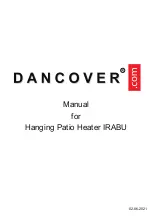
4
USEPHOENIX.COM
1.800.533.7533
connecting to two-slot receptacles. The green grounding
lug extending from the adapter must be connected to a
permanent ground such as a properly grounded outlet box.
The adapter should not be used if a three-slot grounded
receptacle is available.
2.3 Ducting
The Phoenix FireBIRD Compact 20 can be ducted at the
inlet, the outlet or both. The FireBIRD Compact 20 inlet and
outlet duct are designed to accommodate 8” flexible duct.
When selecting flexible ducting keep in mind anticipated
outlet temperatures. Air temperature increase is typically 50
to 80 degrees F. Adding ducting decreases airflow which can
increase outlet temperatures by up to 40 additional
degrees F.
NOTE: It is strongly discouraged to use mylar ducting as this
could burn and cause a fire.
2.4 Control Panel
Fan Mode Switch: This switch allows the user to operate in
‘FAN ON’ or ‘FAN AUTO’ mode. In ‘FAN ON’ mode, the blower
will remain on whenever the unit is energized. This mode
is recommended for normal operation where constant
air circulation is desired. In ‘FAN AUTO’ mode, the blower
will only energize when there is a demand for heat from
the remote thermostat connection. To use this mode, the
CONTROL POWER switch must be set to ‘THERMOSTAT
CONTROLLED.’ This mode is recommended for applications
that do not require constant air circulation during heating.
Control Power Switch: The CONTROL POWER switch can be
used to turn the unit ON, OFF, or set the unit to be controlled
by an external thermostat. In ‘ALWAYS ON’ mode, the
Compact 20 uses an internal thermostat preset at 140F.
Heat will continue to be produced until the air flowing into
the inlet reaches 140F. At this point, internal safeties will
turn off the heating elements until the inlet air temperature
reaches 130F. In ‘THERMOSTAT CONTROLLED’ mode, the
Compact 20 looks for a closed circuit at the THERMOSTAT
connection on the front of the control panel. Any dry contact
switch or the included remote thermostat with 25’ of wire
can perform this function.
Start/Reset Switch: The START/RESET Switch is used to
enable the Compact 20 to produce heat. If at any time
power to the control circuit is lost or if a fault condition
occurs, the Compact 20 will go into the FAULT/NOT
RUNNING mode. Pushing the START/RESET switch will
energize the control circuit and restart the Compact 20.
OK/Running Lamp: The OK/RUNNING lamp will illuminate
when the control circuit is energized. If the lamp is lit, the
Compact 20 is under the control of either the internal or
external thermostat (depending on which thermostat is
selected with the control power switch). In this state, the
heater will be on until it reaches cycling temperatures
(130F-140F) and will then self-regulate at this range.
FAULT/NOT RUNNING Lamp: If the FAULT/NOT RUNNING
lamp is lit, the contactor control circuit is not energized,
which will disable the heater circuits and no heat will be
produced.
Hour Meter: The digital hour meter measures the cumulative
time that the unit is turned on to tenths of an hour. It stores
and displays the total when the unit is unplugged. It resets
to zero after 99,999.9 hours of operation.
Heat ON/OFF Switches: These switches individually
control the heating elements. Each switch connects and
disconnects the power from the receptacle next to it. These
switches are lighted to indicate when power is connected
and the corresponding heating element is on.
Remote Thermostat Connection: There are two spring
loaded terminals for connecting the thermostat wiring on
the control panel. Connect one wire to each terminal. For
applications where the FireBIRD Compact 20 is placed
outside the space to be heated (e.g. ducting heat into a
chamber), the 25’ cord allows you to place the thermostat
inside the heated space.
Grounding Pin
Plug
Adapter
Outlet
Grounding
Means
Metal
Screw


























